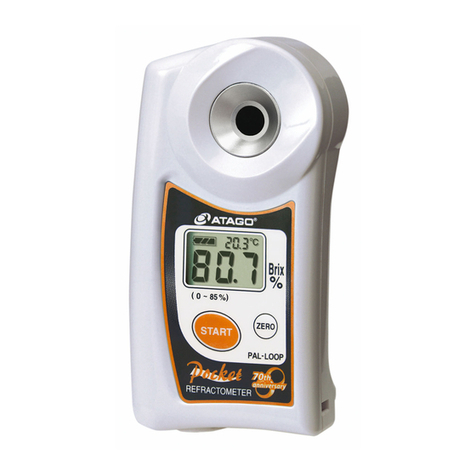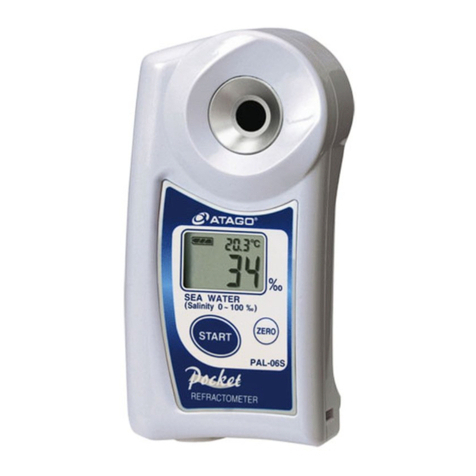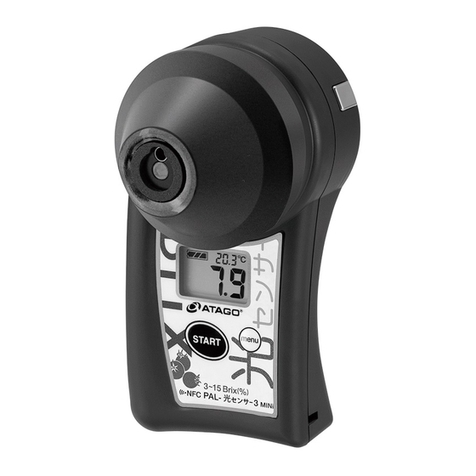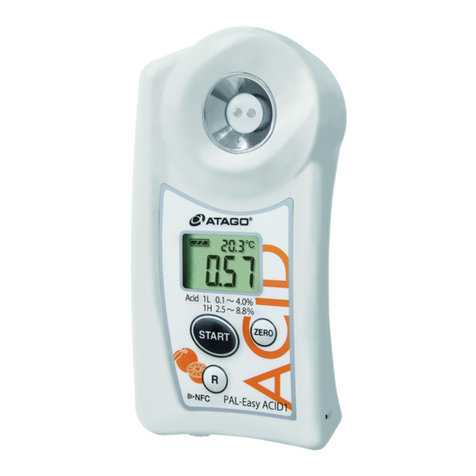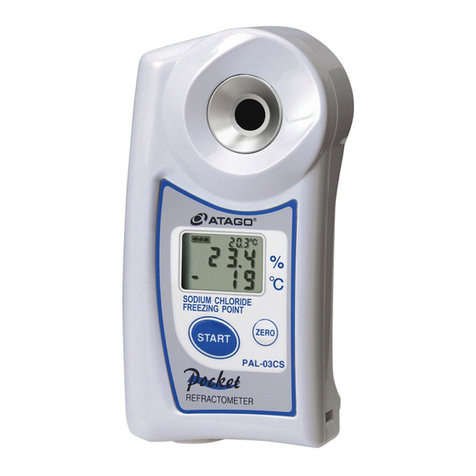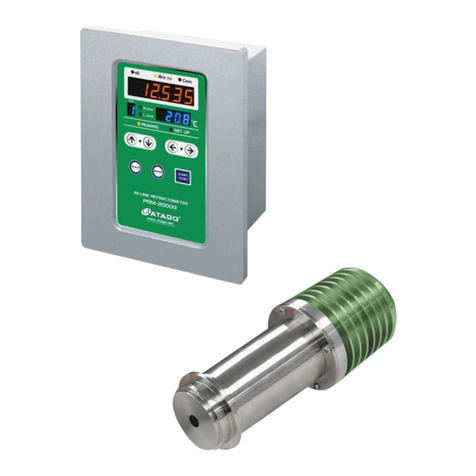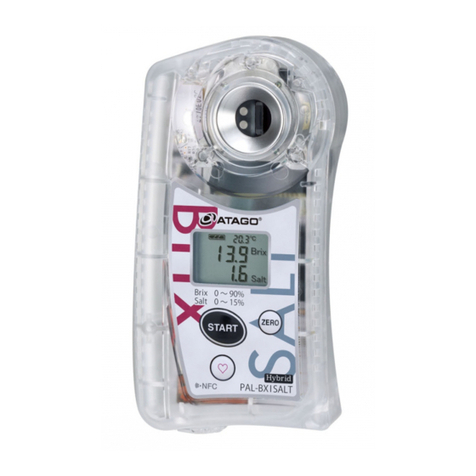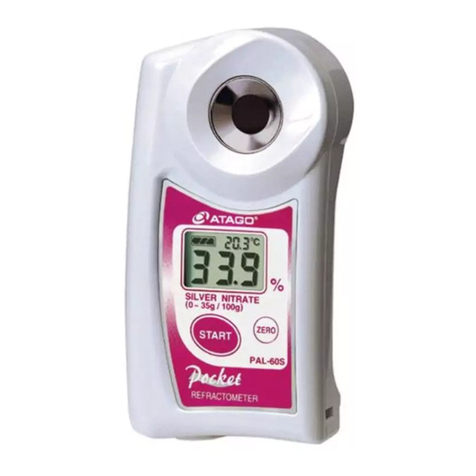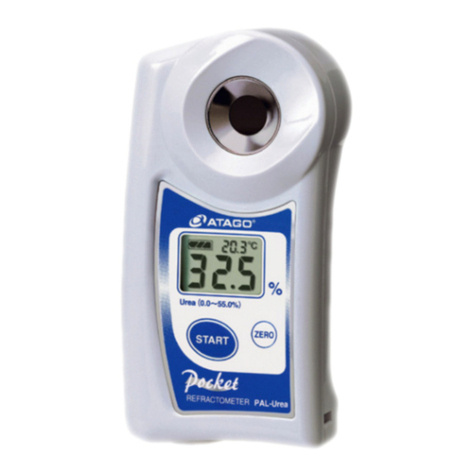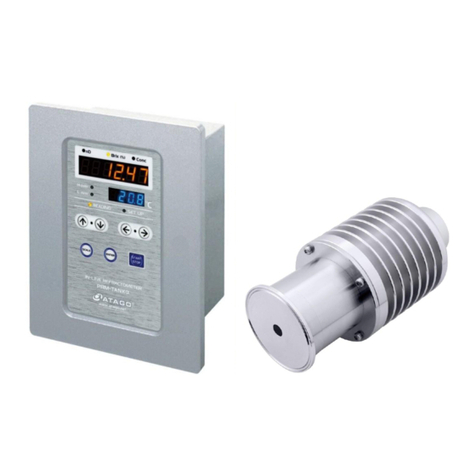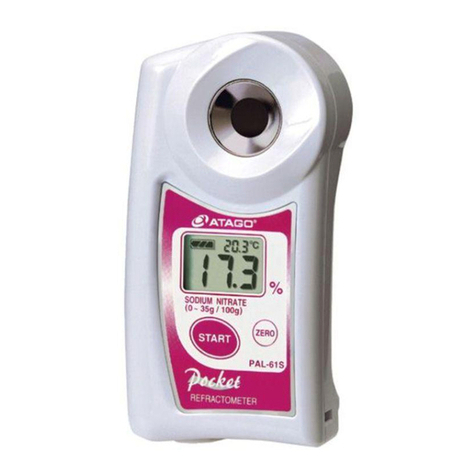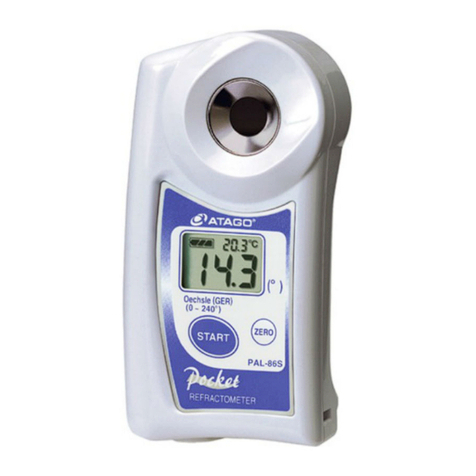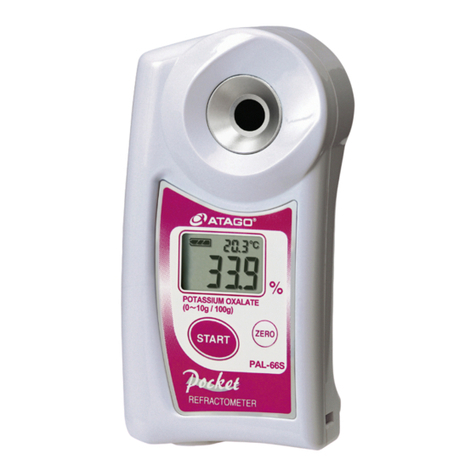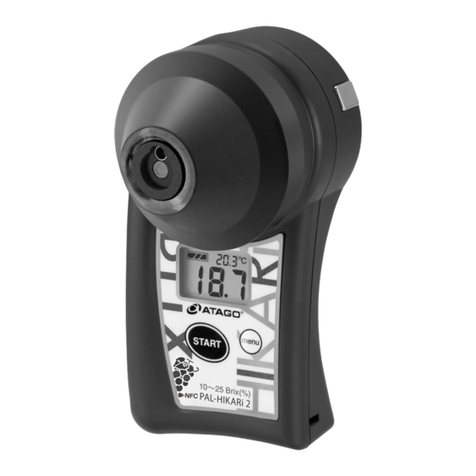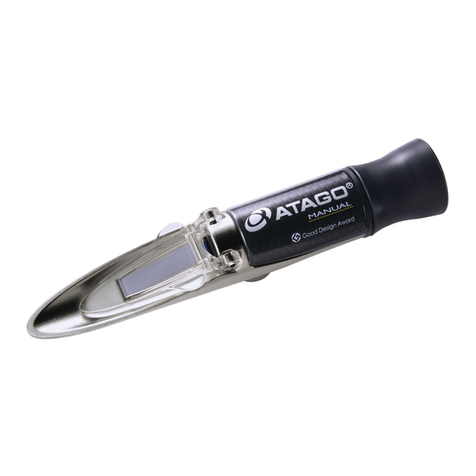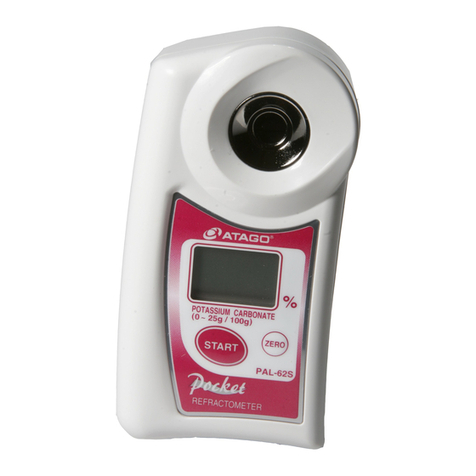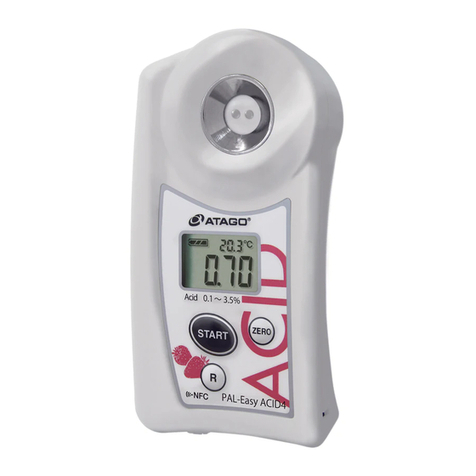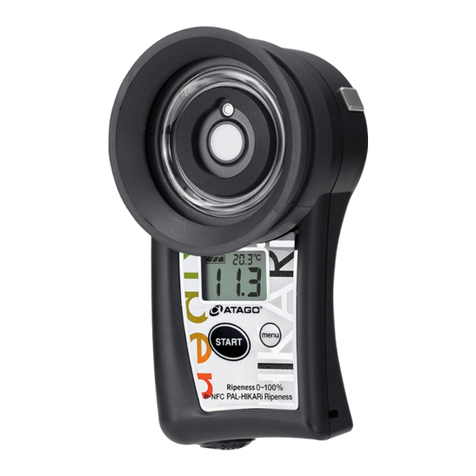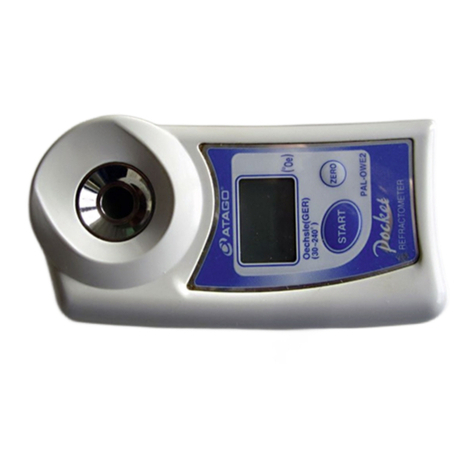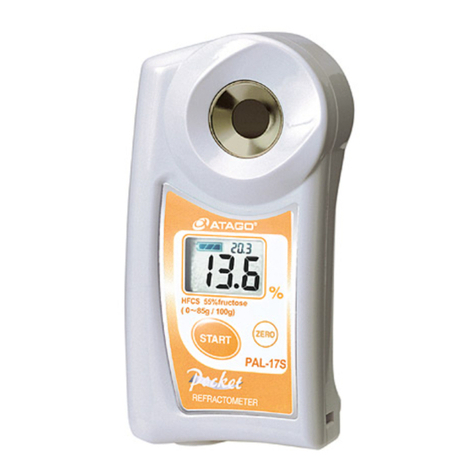
Brix
TDS
Brix represents the weight of sucrose in 100 grams of sucrose solution as percentage by
weight. When other dissolved solids are present in the solution, Brix conversion may be applied.
Brix is a measure of the total dissolved solids in a solution and indicates the combined
concentration of all soluble substances, such as sugar, salt, protein, and acids.
The instrument has a scale for
measuring the TDS (total dissolved
solid) for coffee.
the TDS% (g/100g) for coffee.
Automatic Temperature Compensation
The readings are corrected, based on the temperature of the prism, within the automatic temperature compensation range.
【Caution】
◇ Measurements may fluctuate with hot or cold samples. Wait for approximately 20 seconds to press the START button.
Measurements will stabilize once the instrument acclimates to the sample temperature.
Storage and Maintenance
Store the instrument in
a dry place away from
direct sunlight.
Exposure to humidity
and heat may damage
the instrument.
Do not use organic
solvents (paint
thinner, benzene,
gasoline, etc.) on the
plastic body case.
Clean and dry the sample
stage thoroughly, following
the “Cleaning” instructions.
Store the unit away from
direct sunlight at a stable
temperature with as little
fluctuation as possible.
Repair and Warranty
The instrument is warranted for one year from the date of purchase. This warranty is void if the instrument shows evidence of the
following. Send the included batteries as well if they are still in use.
Having been disassembled by unauthorized personnel
•
Damages to the prism and/or sample stage
Water damage or having been dropped
Having been misused and/or operated outside the environmental specifications
•
Leakage from batteries other than those included with the unit
Repair services are available for a fee after the warranty expires.
Contact an ATAGO authorized service center for service and support.
Please have the serial number information ready when contacting a service center.
Specifications
Measurement range Brix 0.00 to 25.00%
Backlight The backlight stays on for 30 seconds after
(Automatic Temperature Compensation)
any button is pressed.
TDS 0.00 to 22.00%
Maximum number of 100
(Automatic Temperature Compensation)
data history
Temperature 10.0 to 100℃
Output NFC Forum Type 4 Tag
Resolution Brix 0.01%
ISO/IEC 14443 Type A
TDS 0.01%
Output category : Date Time, Brix [%], TDS [%],
Temperature 0.1℃
Temp [degC]
Accuracy Brix ±0.10%
(e.g.) 2017/08/17 09:30:45, 1.35, 1.07, 20.4
TDS 0.15%
Power supply Two (2) AAA alkaline batteries
Temperature ±1℃
International IP65
Automatic temperature
10 to 100℃
Protection class
compensation range
Dimensions and weight 55 (W) x 31 (D) x 109 (H)mm, 100g (main unit only)
Ambient temperature 10 to 40℃
range
Sample volume At least 0.3mL
Measurement time Approx 5 seconds
(or longer until sample temperature
stabilizes)
The product is in conformity with the requirements of the EMC Directive 2004/1
Patent Granted in Japan, United States, Germany, China and Taiwan.
Headquarters: The Front Tower Shiba Koen,
23rd Floor 2-6-3 Shiba-koen, Minato-ku,
Tokyo 105-0011, Japan
http://www.atago.net/
TEL: 1-425-637-2107
TEL: 91-22-2854-4915 / 4071-3232
TEL: 66-21948727-9 ,66-21171549
TEL: 55 16 3913-8400
TEL: 39 02 36557267
TEL: 86-20-38108256
TEL: 7-812-777-96-96
TEL: 234-707-558-1552
TEL: 7-727-257-08-95
1807K Printed in Japan
Digital Hand-held “Pocket” Coffee Refractometer 4533-E10
Instruction Manual
PAL-COFFEE(BX/TDS)
Cat.No.4533
Parts
Contents
Main unit ......... 1
Instruction Manual (this book) ..... 1 Calibration Report .. 1
AAA batteries ........... 2
AAA alkaline batteries are included. Remove the tape from the battery compartment before inserting the batteries.
ATAGO instruments are rigorously inspected to ensure each unit meets the highest standards of quality assurance.
Introduction
Thank you for purchasing the instrument. Carefully read and follow all instructions. Keep this manual for future reference.
Safety Instructions
Read and follow all safety instructions before operating the instrument. Failure to comply with the following instructions may result in personal injury or
property damage.
◇ Ensure safety when handling hazardous materials. Observe precautionary measures and use protective equipment, Be aware of the hazards of such
chemicals and emergency response guidelines.
◇ ATAGO may not be held liable for any injury or damage arising in connection with handling of hazardous materials during the use of the instrument.
◇ Do not drop the instrument or subject it to strong physical shock.
◇ Do not attempt to repair, modify, or disassemble the instrument.
◇ Carefully read this manual to have basic knowledge of the function of each component.
◇ ATAGO is not liable for any loss and damage caused by the measurement and use of this instrument.
◇ Some acids may corrode the glass prism and/or metal sample stage, which may cause erroneous measurements.
◇ Do not use metal tools, such as a spoon, as they may scratch the prism, resulting in erroneous measurements.
◇ Do not use water above 50℃ to rinse the instrument.
◇ Only use the specified battery type. Observe proper polarities, properly aligning the anodes and cathodes.
◇ Store the instrument away from direct sunlight/heat sources and excessive amounts of dust/debris.
◇ Do not expose the instrument to a rapid change in ambient temperature.
◇ Do not subject the instrument to strong vibration.
◇ Do not subject the instrument to extreme cold temperature.
◇ Do not place the instrument under anything heavy.
◇ Loosen the battery compartment cover for air transportation.
<International Protection Classification IP65>
◇ The instrument is water-resistant, not waterproof, and should not be submerged.
<Chemical Resistance of Body Case>
◇ The body case is made of PC. Do not expose it to water vapor or solvents. See the list of “Solvents Harmful to Body Case.”
measurements and
the display.
(POWER botton)
batteries from here.
compartment
ZERO button
zero-setting.
ZERO button
and delete data history.
Lanyard hole
Sample stage
samples on the glass
prism located in the
center of the sample
stage.
Image is for explanation purposes only. It may be
different than the actual product purchased.
LCD
prism temperature,
remaining battery
charge, etc., are
displayed.
The displayed value
is an example.
